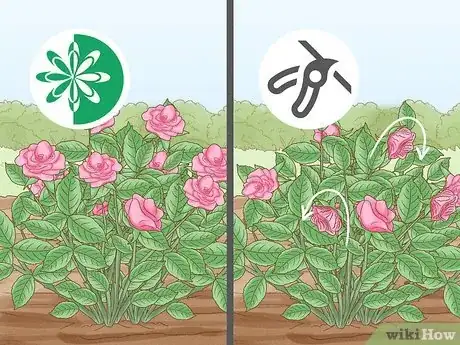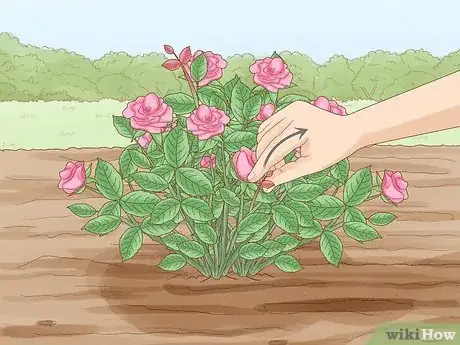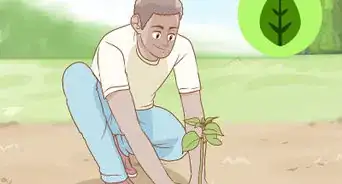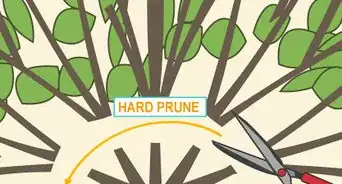This article was co-authored by Lauren Kurtz. Lauren Kurtz is a Naturalist and Horticultural Specialist. Lauren has worked for Aurora, Colorado managing the Water-Wise Garden at Aurora Municipal Center for the Water Conservation Department. She earned a BA in Environmental and Sustainability Studies from Western Michigan University in 2014.
There are 7 references cited in this article, which can be found at the bottom of the page.
This article has been viewed 24,480 times.
Pruning your plants is an important part of keeping any garden full of beautiful, vibrant flowers. There are a few reasons to prune your flowering plants, including to keep them healthy, to encourage more flowers, and to direct a plant’s growth. Generally, you’ll need to do one big trim on a flowering plant each year, along with a series of smaller cuts throughout the year to keep your plants looking their best.
Steps
Promoting a Healthier Plant
-
1Deadhead flowers to remove spent growth during the flowering season. As flowering plants bloom, you may need to remove spent buds to help encourage new flowers and a stronger overall plant. To deadhead a flowering plant, you want to cut the branch or stem off at a 45-degree angle, just above a new bud or pair of true leaves.[1]
- Depending on how thick the stems of your plant are, you will need to use either gardening shears or a hedge trimmer to deadhead your plant.
- Plants that grow aggressively or that produce a large number of flowers may need to be deadheaded more frequently. Try to deadhead flowering plants when there are at least a handful of fading flowers to trim.
- Not all flowers need to be deadheaded. Some self-seeding plants such as columbines, scorpion grass, and poppies do best if you let their blooms grow and fade naturally.
-
2Schedule your annual cut back. Most flowering plants need to be cut back once a year. The time of year you need to prune will depend on when your plants flower. Common flowering patterns for plants are:[2]
- Spring. Plants that flower in the spring should be pruned immediately after the blooms wilt and the flowers fade.
- Summer. Summer-flowering plants should be pruned in the late winter or early spring to allow some time for new growth before the plant starts blooming again.
- Evergreens. Evergreens need to be trimmed at minimum once during the spring before they start blooming again. If you have the time, it’s ideal to prune them in the late autumn or early winter after their flowers fade, as well.
- Annuals. Annuals will need to be trimmed as they are blooming to remove deadheads and encourage new growth.
Advertisement -
3Cut back plants to encourage new growth. Cutting back is an extreme form of pruning that helps encourage new growth and improve a plant’s overall appearance. Cutting back involves the removal of all leaves, stems, and buds. Use hedging shears to trim the plants down to about 2 inches (5.1 cm) above the ground.
- Remember to wear thick gardening gloves while you're cutting back your plants. If you are working with flowers like roses that have thorns or stickers, you should also wear a durable, long-sleeved shirt.
- Cutting back should only be done after a plant has flowered.
- After a flowering plant has been cut back, it may need a little more attention. The plant needs to be well-watered, and the soil surrounding it should be aerated.
-
4Pinch flowers in between annual trims to encourage healthy growth. Pinching removes the growing tips and first set of leaves as a plant starts to grow. Use your fingernails to pinch a stem just above the node. Pinching right before a flower blooms will help keep it from getting too heavy or floppy and extend the bloom time.
- Pinching can be done with garden shears. For many plants, though, you can also pinch stems with your fingers by using your nails to cut through the new growth.
- Pinching also helps produce branching growth and flowering stems.
Getting More Flowers
-
1Pinch flowers to stagger bloom times. Just as pinching flowers can promote a healthier plant, it can also help you get more flowers throughout the growing season. As your plant starts to bloom, use your fingers to pinch about half the buds on the plant. The buds that you pinch will bloom 3-4 weeks after the buds you leave in place.
- Try to pinch buds evenly across the plant. The process won’t be effective if you leave one side of the plant to bloom and remove all the flowers from the other side.
- In most cases, pinching buds can be done with your fingernails.
-
2Remove terminal and side buds to promote new flowers. Look for buds at the tip of a shoot and those facing toward the inside of your plant. Depending on the plant, you can use gardening shears or your fingernails to pinch the bud where it meets the stalk.[3]
- Leave the buds facing outward intact. These are flowers that will get the necessary sun to flourish and keep your plant looking healthy.
- Removing terminal buds and inward-facing buds will help redirect a plant’s energy to producing more flowers.
-
3Thin away old stems that have decreased in flower production. Use gardening shears or hedge trimmers to cut away stems that are no longer producing healthy flowers. If your plant is still crowded, remove any new growth so that the remaining stems have room to grow. Try to cut the stems down as close to the ground as possible.[4]
- Thinning your plant will focus the plant’s energy on the stems producing vibrant, healthy flowers.
- Thinning should be done regularly on quick-growing plants to make sure the flowers will renew themselves. At a minimum, try to thin a plant at least once before it blooms and once after the blooming season.
Directing Growth
-
1Pinch new stems as they arise to control future growth. Pruning early on young plants makes it much easier to control their growth, as opposed to later pruning to correct growth. Check on new stems to make sure they are following the growth plan you have for your plant.[5]
- If new stems are not growing in the direction you want, use your fingers or gardening shears to pinch them as close to the stalk as you can right above an outward-facing bud or a bud facing the direction you want it to grow.
-
2Shear a flowering hedge or bush to shape it. Shearing is a process that generally results in a square or rounded shape. Use hedge trimmers to shape your plant. Try to make your bush wider on the bottom than it is on top to ensure all leaves get the sunlight they need to flourish.[6]
- If you aren’t used to shearing, a rectangular or trapezoidal shape will be easier to achieve than a round shape. Use a string line tied between a stake in the ground and the edge of the bush as a visual guide for your cuts.
- Shearing stimulates buds to create new growth. Regular shearing as your bush starts to outgrow its shape will help direct future growth.
- Some bushes do better if you shape them on their natural growth patterns. Follow the contours of the growth for a healthy trim.
-
3Thin a flowering plant to control where it spreads. Thinning a flowering plant can control where it grows. Use hedge trimmers or a pruning saw to cut down stems outside your desired growth area. These should be taken down as close to the ground as possible.[7]
- If you want your plant to be bushier, thin out old growth in the center of the plant. This will encourage the areas most exposed to the sun to expand outward.
Things You’ll Need
- Gardening shears
- Hedge trimmers
- Gardening gloves
- Pruning saw
References
- ↑ https://extension.illinois.edu/roses/prune.cfm
- ↑ https://www.bhg.com/gardening/trees-shrubs-vines/care/what-to-prune-when/
- ↑ https://www.backyardgardener.com/garden-tip-articles/garden-guide/disbudding-flowers-and-fruit-garden-plants-design-information/
- ↑ https://www.finegardening.com/article/maintenance-pruning
- ↑ https://extension.umaine.edu/publications/2169e/
- ↑ http://www.chicagotribune.com/lifestyles/home/ct-sun-0410-garden-morton-20160404-story.html
- ↑ https://www.familyhandyman.com/landscaping/bush-pruning-tips-for-healthier-bushes/view-all/




































































